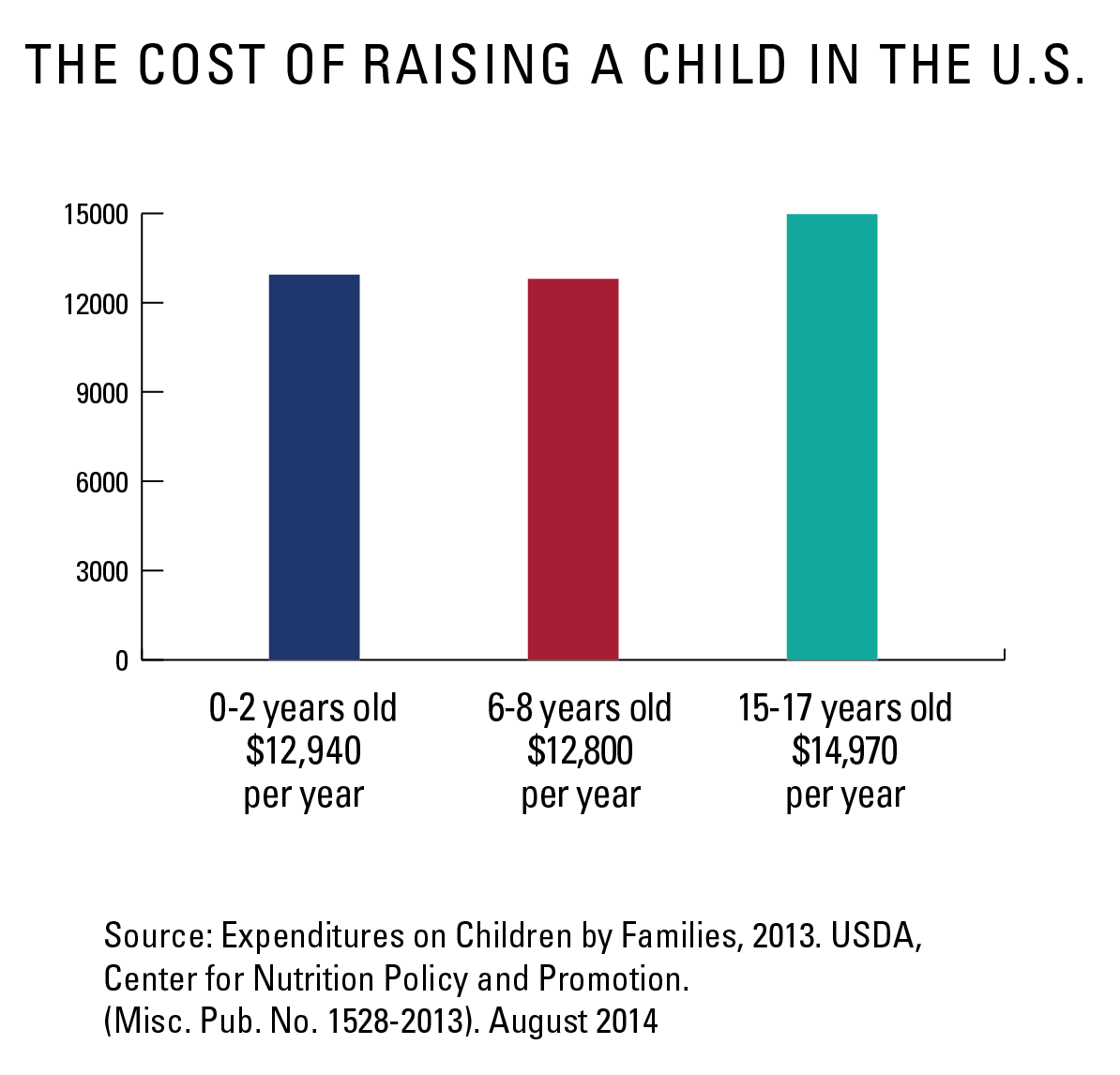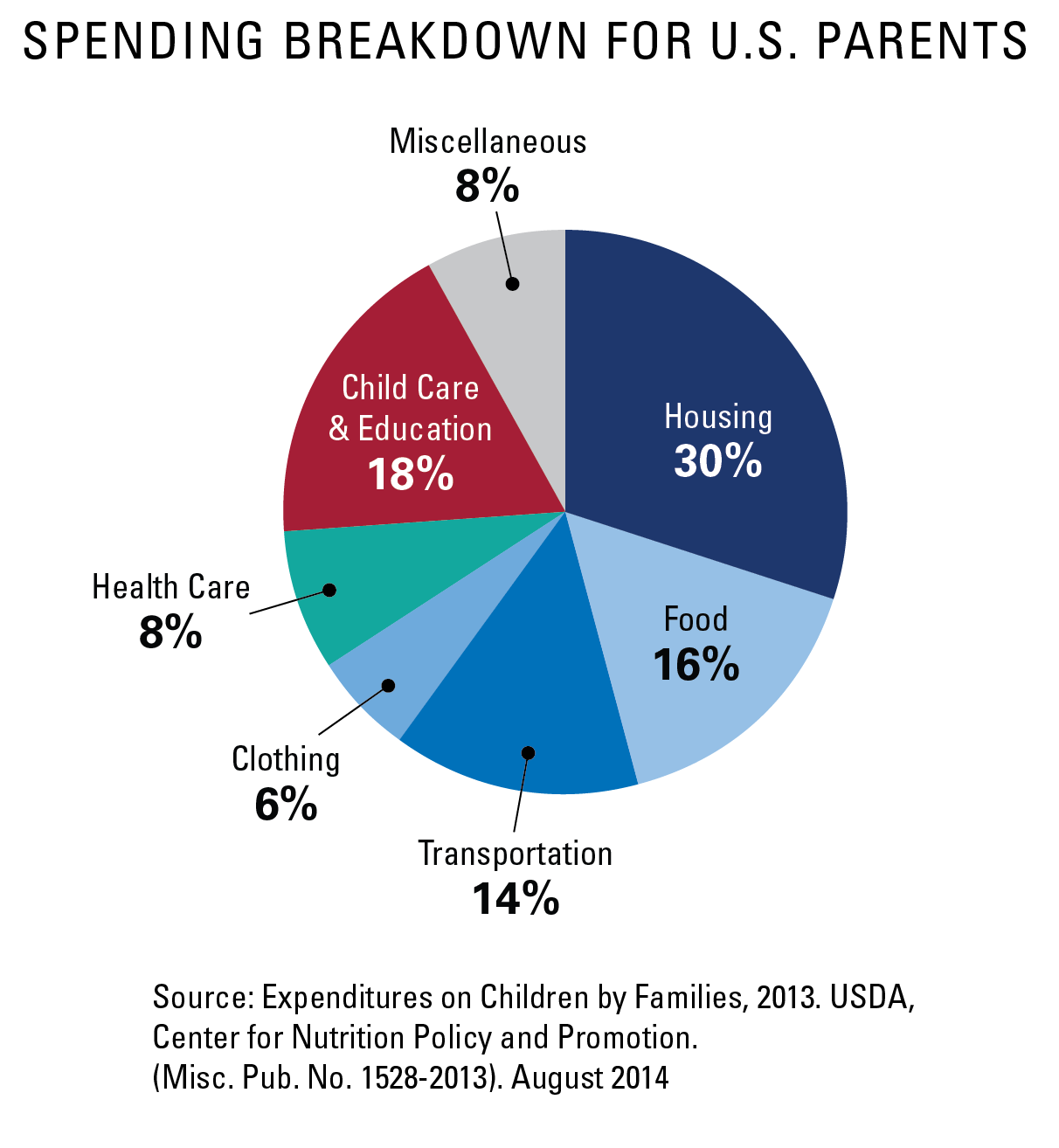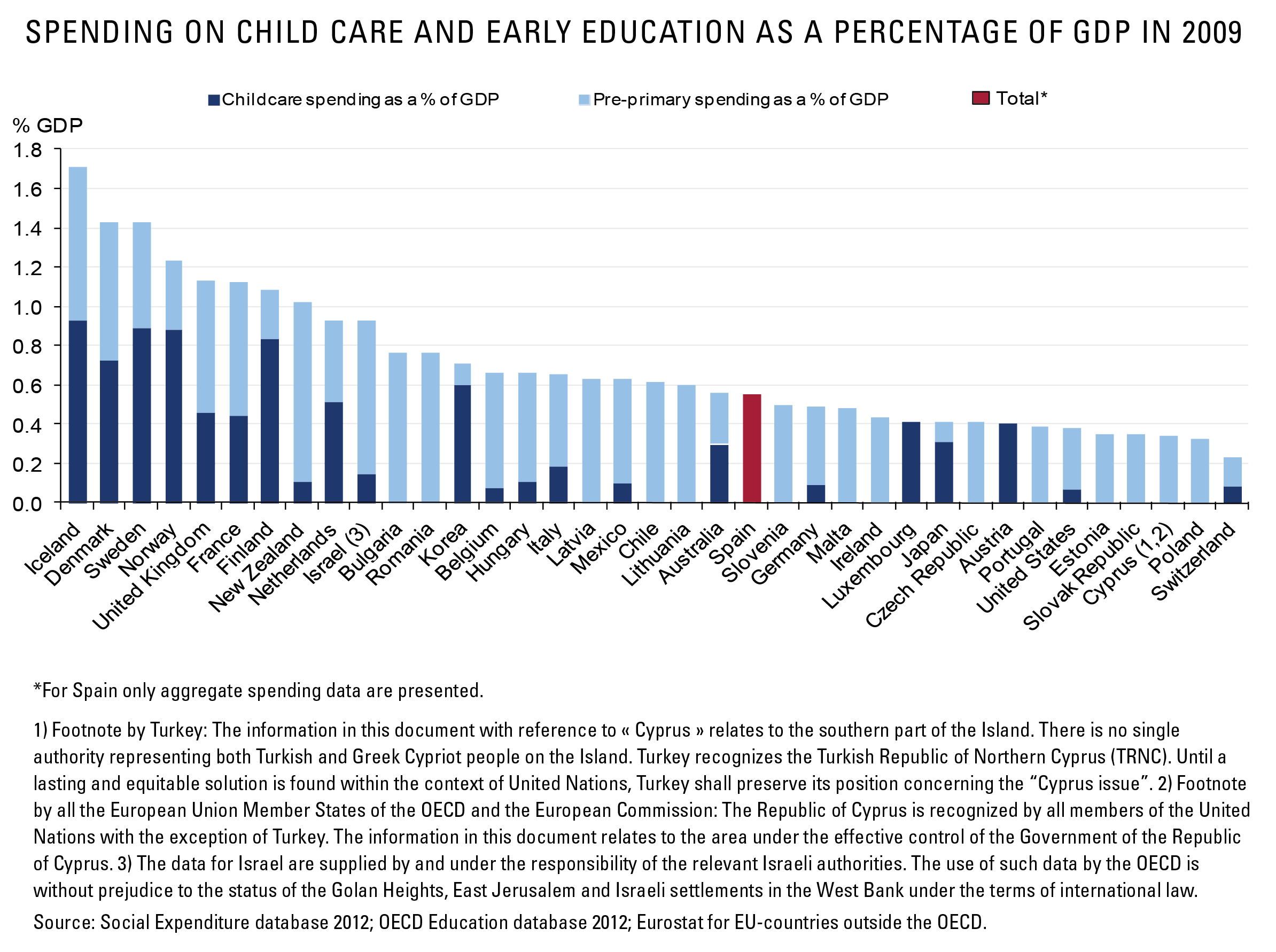So you’re going to have a baby. Congratulations! It goes by fast, so enjoy it. Oh, and pardon the unsolicited advice, but start saving. Now.
The piano lessons. The soccer camp. The orthodontia. And then there’s college. Perhaps you’ve even begun to research the best 529 plans. You have close to two decades to save for that. But the money you really should be socking away now is for day care: That bill comes due a whole lot sooner and, in a lot of places in the U.S., it’s even more expensive per year than college.
According to a study released last year by Child Care Aware America, a group of child care resources and referral agencies, the annual cost of day care for an infant exceeds the average cost of in-state tuition and fees at public colleges in 31 states. In New York, for instance, day care costs nearly $15,000 a year; average in-state college tuition is $6,500.
Unlike many developed countries where child care and early education is heavily subsidized, the U.S. has no national policy on child care. “When we compare what we do as a nation to what other developed countries do in terms of child care, it’s embarrassing and it’s tragic,” says Stewart Friedman, practice professor of management at Wharton. “Part of it is rooted in the American ethos of individualism. You’re supposed to make it on your own.”
Not only does the high cost of child care in the U.S. hit the bottom line of individual families, it also has repercussions for the economy as a whole. For one, the tremendous strain on household budgets dents consumption, which in turn hinders growth. Second, the burden of dealing with (and paying for) child care is seen as a culprit that forces women to drop out of the labor market. And finally, the difficulties associated with child care are for some a deterrent to have children in the first place. The issue there, of course, is that in pure economic terms, today’s babies are the workforce of the future.
“The cost of child care is one of the factors causing young people to opt out of parenthood — and that’s a problem,” Friedman notes. “It’s a problem that can be solved in terms of what the private sector can do, and what government can do to improve child care infrastructure and paid family leave.”
‘A Long Leap into the Dark‘
In a way, it’s odd that a universal child care plan isn’t a bigger part of today’s national debate. Numerous studies point to how important the early years are in the brain development of children. And amidst an achingly slow economic recovery and at a time when the government has taken on greater responsibility for the nation’s health, it stands to reason that the implementation of a federally funded child care network would put many American families on better financial footing.But while President Barack Obama has pledged to place low-income four-year-olds into pre-kindergarten and patchwork efforts exist here and there in states like Oklahoma and Georgia, for the most part, child care is not seen as an issue of national import.
And yet, it is both a powerful driver of — and drain on — the economy. Consider, for instance, that employee absenteeism as the result of child care breakdowns costs U.S. businesses $3 billion a year. “Child care is an invisible part of the economy,” says Ellen Galinsky, president and co-founder of the Families and Work Institute. “Economists don’t typically look at child care — they don’t often study the people who are employed by it, nor do they look at how many of our nation’s employees are dependent on it [in order to do their jobs].”
Even though the proportion of family income spent on child care has stayed constant since 1986 at around 7%, child care costs have nearly doubled in the last quarter century, according to a recent U.S. Census Bureau report. In 21 states and the District of Columbia, the average annual cost of care for a four-year-old in a day care center exceeds 10% of the median household income for a married couple with children, according to Child Care Aware America.
“When we compare what we do as a nation to what other developed countries do in terms of child care, it’s embarrassing and it’s tragic.”— Stewart Friedman
“This has big economic implications,” says Lotte Bailyn, emerita professor of management at the MIT Sloan School of Management. She notes that the vast majority of people paying for child care are families who are typically at the beginning of their earnings trajectory, which makes the financial burden all the harder to manage. “Child care is so expensive that there is very little discretionary money for consumption. It may be one of the things contributing to the slowness of our recovery and pulling down demand.”
Universal child care nearly became a reality in the U.S. In 1971, Congress passed the Comprehensive Child Development Act on a bipartisan vote. The bill, which was sponsored by two democrats — Sen. Walter Mondale, of Minnesota, and Rep. John Brademas, of Indiana — created a system of federally funded child care centers throughout the U.S. The centers, which were to provide early education for young children as well as after-school care for older kids, would also have provided medical and dental services.
Fees would be based on a family’s income level, and most middle-class families would qualify for at least subsidized tuition. The Act, in the words of Mondale, was “designed to assure that every child has a fair opportunity to reach his full potential.”
But President Richard Nixon vetoed the bill. Calling it “truly a long leap into the dark for the United States government and the American people,” Nixon said the Act would “commit the vast moral authority of the national government to the side of communal approaches to child rearing over the family-centered” approach.
More than 40 years later, the veto represents the stigma around welfare reform. “Welfare is not seen as a safety net,” says Bailyn. “It’s not seen as a way to have a decent society. It’s associated with lazy people. There is no thought about how it will affect children.”
According to data from the Center for American Progress, low-income families spend a much larger portion of income on child care. In 2010, for instance, families who made less than $1,500 per month with children under the age of five spent more than half of their monthly income on child care expenses (52.7%). Only about 30% of low-income families using center-based child care, and 16% using an in-home care center for a child under the age of six, received subsidies, according to the data.
Some of the working poor make do in other ways. Take, for example, the arrest of Debra Harrell earlier this summer. Harrell, a South Carolina mother, was arrested for leaving her 9-year-old daughter in a park for hours while she worked at a nearby McDonald’s. She was charged with unlawful conduct toward a child, a felony punishable by up to 10 years in prison. Her arrest sparked a national debate.
“Those employees who are most needy — single mothers or people who work in the fast food industry, say, whose work is prone to shift changes — are left with nothing,” Bailyn notes. “They represent a group of people that need to work to take care of their children, but they are not supported with anything close to high-quality child care.”
Social Good vs. Individual Choice
What does the U.S. do right in terms of child care? “Unfortunately, the answer is not a lot,” says Nancy Rothbard, professor of management at Wharton. “The U.S. does not offer state-subsidized child care, and its family and medical leave is still far below most other developed countries.
“We can’t just wave a wand and fix just one [part of] the problem,” she adds. “It is an issue that is so deeply woven into the way we tax, the way we approach business, the way we use community resources and the kind of safety net that we provide.”
Mothers in the U.S. are entitled to 12 weeks of maternity leave, but employers are not required to pay them during that time. By contrast, women in France receive 16 weeks of paid maternity leave; women in Germany receive 14 weeks, and women in Poland receive 26 weeks of paid leave courtesy of social security, according to figures from the International Labor Organization. Other countries that provide new mothers with at least 14 weeks of paid leave include China, Vietnam, Zimbabwe, Congo, Brazil and Costa Rica, according to the ILO.
The structure of U.S. families and the fact that most Americans don’t live in intergenerational families and communities is another factor that “contributes to the struggle” around child care, adds Rothbard. “We primarily have an individualistic society in the U.S.,” she says. “Other cultures rely on family and community support [to collectively raise children], and we don’t have that here.”
Moreover, in many other developed countries, high-quality child care and early education are part of the national infrastructure. In Europe, for instance, formal pre-primary education in the public school system is often the norm. But in the U.S. it is the exception. Indeed, on almost every measure of child care and early education, the U.S. ranks behind most of the other countries in the Organisation for Economic Co-operation and Development (OECD).
Across OECD countries, 84% of students in early childhood education attend programs in public schools or government-dependent private institutions; in the U.S., 55% of early childhood students attend programs in public schools.In Mexico, for instance, states are now obligated to provide early education services for children over three years old, and attendance has been made compulsory for all children from this age, according to the OECD. In the U.S. the typical starting age for early childhood education is 4 years old, while in 21 other OECD countries, it is 3 years old or younger.
In addition, many countries are investing heavily in early childhood programs. New Zealand and Korea have implemented early education curriculum standards; Finland, meanwhile, has focused on improving qualifications, training and working conditions for early childhood education professionals, according to the Center on International Education Benchmarking. In the U.S., however, child care situations vary greatly. Numerous longitudinal studies show that children enrolled in high-quality early education programs do better in school, are more likely to attend college, are more likely to earn higher wages, and are less likely to be involved in the criminal justice system.
“Child care is an invisible part of the economy.”— Ellen Galinsky
It’s also worth pointing out that child care workers in the U.S. are very poorly paid. According to a U.S. Census Bureau report, the median wage for a child care worker in 2011 was $19,098, which compares to a median wage of $19,680 in 1990 in constant 2011 dollars. Child care workers in other countries tend to do better. According to estimates from UNESCO and OECD, the salaries of public early childhood educators from Denmark are Kazakhstan are 85% to 100% of primary school teachers’ salaries; their earnings are at parity in the Dominican Republic and New Zealand.
“I like to say that the closer you are to the diaper [in the U.S.], the less valuable you are in the labor market,” says Wharton’s Friedman, who notes that elder care workers are also poorly paid. “[People who work in the child care profession] are caring for our most precious assets at a time when their development is most crucial. The fact that their wages are at the bottom, there’s something wrong here.”
At the heart of the issue, adds MIT’s Bailyn, is that in other countries, children are viewed as a social good. “But children in this country are seen as an individual choice,” she notes. “If you choose to have them, you’ve got to take care of them.”
Galinsky, who co-directs a study called When Work Works, a project on workplace flexibility and effectiveness, concurs. “Other countries such as Denmark, France and Finland see it as part of their national self interest to support families as they transition to parenthood,” she says. “Child care is viewed as the general responsibility of the country. Here, child care is seen as an individual responsibility.”
‘A Women’s Issue’
An “individual responsibility,” perhaps — but often, the individual responsible is the mother. Child care here is a tale of two socioeconomic classes for women, notes Wharton’s Rothbard. “A lot of women can’t afford not to work. So they make do and cobble together whatever child care situation they can. It’s stressful. On the other end of the spectrum, there are women who have the resources to afford [high-quality care], but they, too, are cobbling it together. It’s expensive and it’s stressful and some [who can afford to pay for care] decide to opt out [of having children]. It’s a struggle on both ends.”
Indeed, even in the era of Lean In, and at a time where workplace flexibility and support occupy a large part of the national discourse, child care is typically viewed as a “women’s issue.” In many families, for instance, it is the mother who interviews and primarily deals with the sitter, and it is the mother who tours the day care center and does the majority of drop-offs and pick-ups.
It is also the mother who often sacrifices her career for the sake of the children. This is because many professionals view child care as a woman’s expense, and not as a family expense. “Women feel they must justify how much they earn versus how much they spend [on child care],” says Galinsky.
The upshot is that because women tend to make less money than their male counterparts (in this case, their spouses), some make an economic decision to stay home with the children instead of paying for expensive child care and dealing with the resultant hassles. But it is a misguided short-term calculation, Galinsky notes. “There is a lot of research that shows that staying out of the workforce diminishes earning power later on, but when people operate with a scarcity mindset, it’s hard to see the big picture.”
Some experts believe that universal day care would increase women’s rate of labor participation. It could also lead to a rise in the number of high-ranking women in corporate America. (With better child care options, fewer women would drop out of the workforce thereby expanding their professional opportunities.)
According to a Pew Research analysis of Census data published earlier this year, the share of stay-at-home mothers has risen over the past 15 years, to 29% in 2012. Citing a 2010 Census paper, which focused on married stay-at-home mothers, the analysis said that the rising cost of child care helped drive the trend. “Especially for mothers who have more than one child under five, the cost of day care might be higher than she could support unless she has fairly high earnings,” it said.
“The lack of institutionalized support [in the U.S] stymies women,” says Lynn Roseberry, a professor at Copenhagen Business School in Denmark and author of Bridging the Gender Gap. “We still have this outmoded notion that children should be raised by their mothers, which is propped up by the idea that women are the best caregivers.”
Even when women continue to work after having children, the cost and burden of managing their child care situations frequently hurts their career prospects, she adds. “They are often stranded down the hierarchy because of the child care piece. In the States, women often have to cobble together a child care situation themselves. It’s hard, it’s time-consuming and it sucks your energy.”
“Other cultures rely on family and community support [to collectively raise children], and we don’t have that here.”— Nancy Rothbard
Moreover, there is no sisterhood among working mothers in the U.S. “American women — even highly educated ones — tend to individualize their situations,” says Roseberry. “They don’t realize they share the same struggles and problems as other women. It makes them willing to accept less. It also makes them prone to reduce their level of ambition.”
Workforce of the Future
The difficulties and cost associated with child care may also be having an impact on whether or not some people decide to have kids in the first place. Consider, for instance, the work of Friedman, who is the founding director of the Wharton Work/Life Integration Project. He does in-depth research and longitudinal surveys into the lives, careers and families of Wharton students and alumni.
In 1992, he surveyed more than 450 Wharton undergraduate students as they graduated about whether or not they planned to have or adopt children. In 2012, he asked the same question of the latest crop of Wharton undergraduates. In 1992, 79% said that children were in their future. But in 2012, only 42% said so.
“That is a huge drop-off,” says Friedman, whose most recent book, based on this research, is Baby Bust: New Choices for Men and Women in Work and Family. “One of the things I kept hearing again and again [about why people weren’t planning to have kids] was the cost of child care. Young people would say to me, ‘I can’t figure out how I will be able to afford it.'”
According to a recent report from the Centers for Disease Control and Prevention’s National Center for Health Statistics (NCHS), the general fertility rate for the U.S. reached a record low in 2013: 62.9 births per 1,000 women aged 15-44. The fertility rate has dropped steadily since 2007, according to the study. Of course, the high cost of child care isn’t the sole cause of the decline, but it is “a great inhibitor,” says Friedman.
And yet, Friedman sees some hope for the future as more and more people demand action on the outdated child care policies in the U.S. A 2012 poll conducted by the National Partnership for Women and Families showed strong support for family friendly policies, such as paid family leave. Support was especially strong among young people. According to the poll, 69% of women and 68% of people under 30 considered these policies “very important.”
New York City’s vastly expanded pre-kindergarten program is another reason for optimism. The program enrolled more than 51,000 students this year, and Mayor Bill De Blasio aims for an enrollment of 70,000 next year. The expansion, which was funded with $300 million in state money, was executed in only six months.
“Young people today are more inclined to want to invest in and support policies that make caring for our children part of the national infrastructure,” says Friedman. “[They want policies] that enable both men and women to fully participate in the workforce.”






